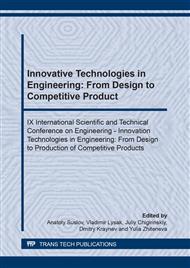p.134
p.139
p.147
p.152
p.157
p.161
p.166
p.170
p.174
Removal of Defective Layer after Electrical Discharge Machining
Abstract:
This study investigates the possibility of electrochemical removal of the defective layer formed on the surface of the product after its electrical discharge machining. A set of experiments was conducted in different electrolytes based on aqueous and aqueous-organic solvents. The experiments were to trace the influence of such settings of electrochemical machining as current density, electrolyte pumping speed, electrolyte temperature, and an electrode gap upon both the dynamics of metal removal and surface quality. Morphology of the obtained surface was examined by an Olympus BX-51Microscope. The dynamics of removing material (stock) from the work piece was inspected. Appropriate adjustments were made to the machining parameters during the machining of 65G steels, and a preferred composition was selected for the working medium. A sufficient design for production tools was proposed. Pitting corrosion was discovered on the surface of the samples in all studied modes of electrolysis. It was observed that switching from aqueous electrolyte to aqueous-organic electrolyte gave lower material removal rate and longer machining time accordingly. At the same time, a reduction in surface roughness was visualized, together with smaller pits and lower density of their distribution. The obtained results may be applied in operation design for electrochemical machining of steels with relatively high carbon contents.
Info:
Periodical:
Pages:
157-160
Citation:
Online since:
November 2019
Authors:
Price:
Сopyright:
© 2019 Trans Tech Publications Ltd. All Rights Reserved
Share:
Citation:


